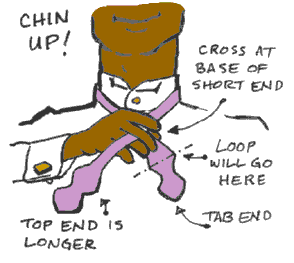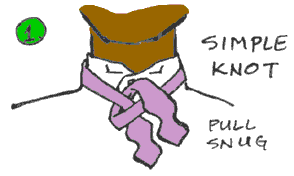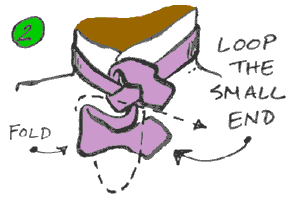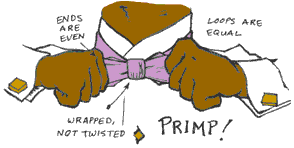I've recently realized that not a lot of people know how to tie a bowtie — or, rather, not a lot of people know that they already know how: it's just like a shoelace, except a bit more careful.
And more disturbing is the number of people who think a tuxedo is uncomfortable. That's mainly because so many people don't bother to have them tailored to really fit well, and that the most common occasion for tuxes is wedding season, when so many have to rent them in order to match. Hear this: rental places don't want you to have a tux that fits. They just want you to have one that isn't too small. The result is that for the last wedding I was in the fellow measured my neck as 171/2 inches. Yuck! No wonder so many men pull and itch at their necks and shoulders. It's just like with regular suits: if you get shirt, pants, and jacket that are all cut to really fit you, then it's one of the most comfortable things you can wear. And, as men know better than women, if you're not comfortable, you're not really stylish.
Nothing looks better than a guy in a slammin' suit. Except maybe a guy in a slammin' tux. On the other hand, nothing says "the groom" more than having one of those pre-tied bowties. Face it: what kind of goob would wear a pre-tied necktie with a regular suit? The real one just looks better, because it has that natural heft to it, rather than the flat, affectless look of a clip-on. Look at a homemade apple pie cooked from scratch, compared with a store-bought one, and you'll see the same thing.
Then there's the issue of taking it off: at the end of a tuxedo evening, undoing the bowtie is just about the sexiest thing a man can do, perhaps because it's a kind of symbolic striptease. There's something provocative about formal clothing in slight disarray, isn't there? A guy could take off the tie, and shirt, completely, leaving just a t-shirt, and that doesn't give off nearly the heat of being seen in a loosened tux shirt with bow tie undone. The suggestion, I think, is that much has come before, and much is still to come: there has been some occasion in which I've presented myself, ceremonially prepared, to the world — and now that occasion is over and we're entering a more unconstrained moment. But the formality of the occasion still colors what is to come, because events leak onto each other. (Chili is good, and chili in cold weather is great, but chili in cold weather right before a football game is exciting.) Disheveled formal clothes tell an entire story, compacted into a single and powerful image. So the act of disheveling them becomes a ritual itself, and it produces a frisson that is irreplaceable.
So. Get your own tux, and get a real bowtie. Ladies, drop a few bucks and get him one. (Then untie it yourself.)
:: :: :: :: :: :: :: :: :: :: :: :: ::
set the stage
. . . . . . . . . . . . . . . . . . . . . . . . .

Collar buttoned? Put the bowtie around your neck, seams to the inside. Let the widening point on your nondominant side hang down from the collar button by your collarbone (so if you're left-handed, lay it on the right side). The other side should be a little longer.
Hold the spot just above the widening point with your nondominant hand between thumb and forefinger. This spot is where you'll tie the knot.
:: :: :: :: :: :: :: :: :: :: :: :: ::
form the simple knot
. . . . . . . . . . . . . . . . . . . . . . . . .

Cross the slightly longer end over the spot, pass it around behind and up through the top. Let it hang down. This forms a simple knot and can be pulled snug here, with the end on top still a little longer. The long end is now in your nondominant hand.
:: :: :: :: :: :: :: :: :: :: :: :: ::
make the first loop
. . . . . . . . . . . . . . . . . . . . . . . . .

Fold the shorter end over on top of itself (not behind it). The wide point becomes the edge of the loop and the narrow point should lie right on top of the actual knot. Hold this loop at its base with your nondominant hand.
:: :: :: :: :: :: :: :: :: :: :: :: ::
wrap the second loop
. . . . . . . . . . . . . . . . . . . . . . . . .

Wrap the longer end carefully over and down with your dominant hand, then around behind the first loop. Do not twist the tie — wrap it around.
Now insert the longer end through the knot: push a loop with your finger through the central knot, and tug it through. This creates the second loop. (Remember: this is just like a shoelace.) Hold the first loop with your dominant hand, and carefully pull the new loop a little tighter. Be careful not to pull the ends out.
When pulling the knot tight, grasp the loops and ends equally in both hands. Pull evenly. Sometimes a bow will remain unruly until you have cleaned the knot. Then you can adjust it into the final shape.
:: :: :: :: :: :: :: :: :: :: :: :: ::
primp the bow
. . . . . . . . . . . . . . . . . . . . . . . . .

All bowties will require some fussing to get the ends straight and the knot square. Adjust the loops and ends so that their lengths are equal on each side, and both sides are even.
The last thing you should do with a bow is take a side in each hand, pull the knot firmly taut, and then pull the bow out away from the collar. A properly starched and tied bow will stand out smartly at an angle of about 30 degrees.